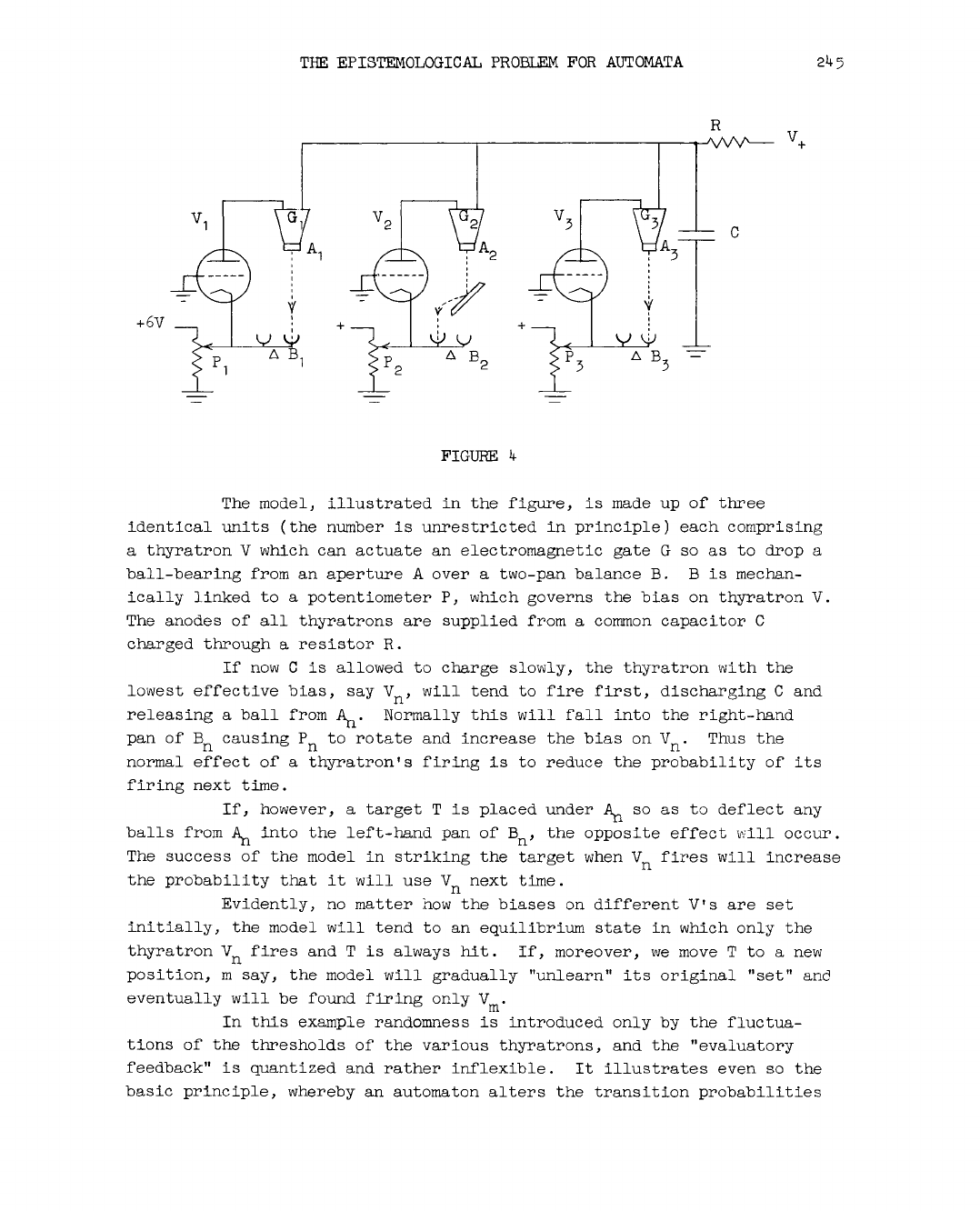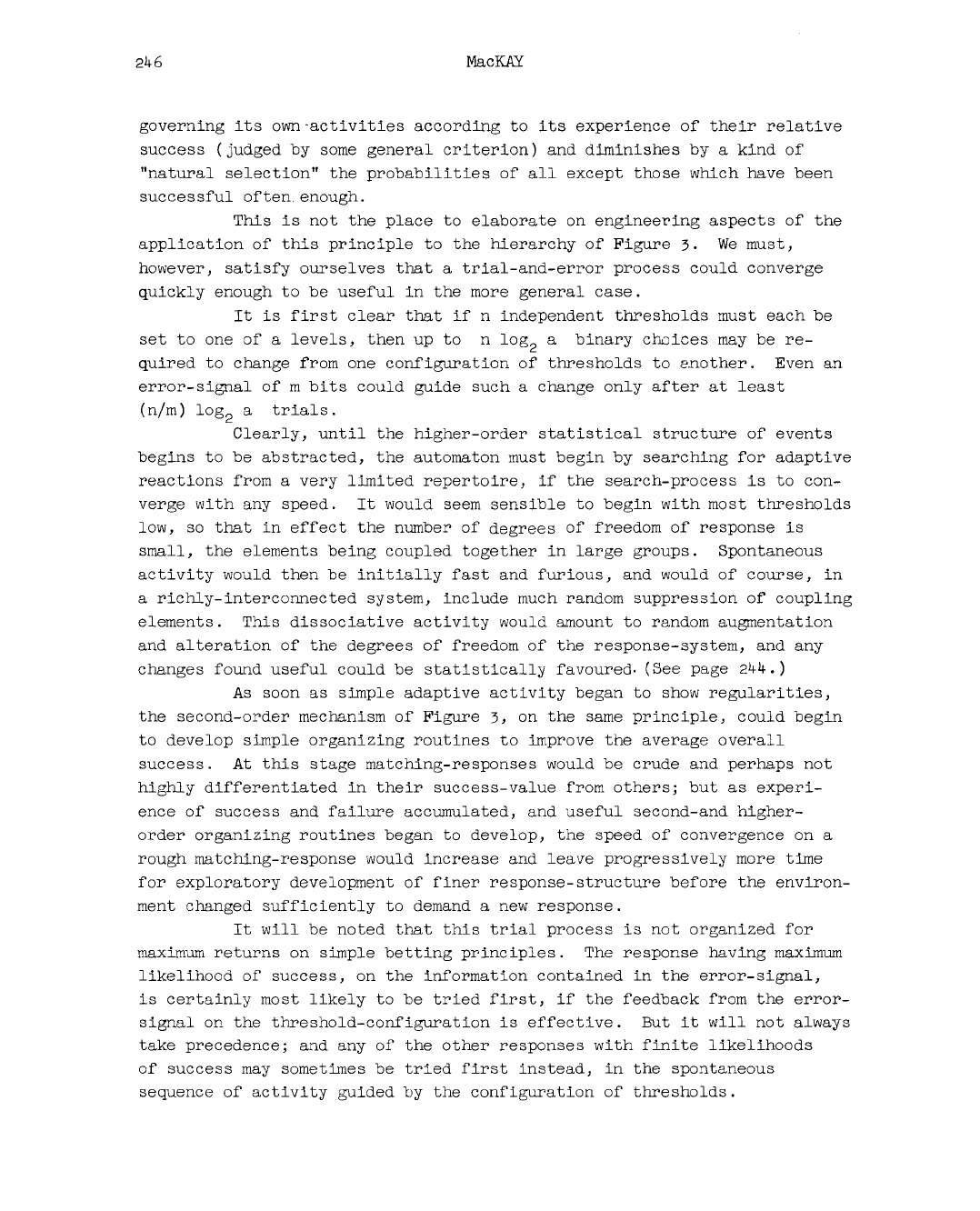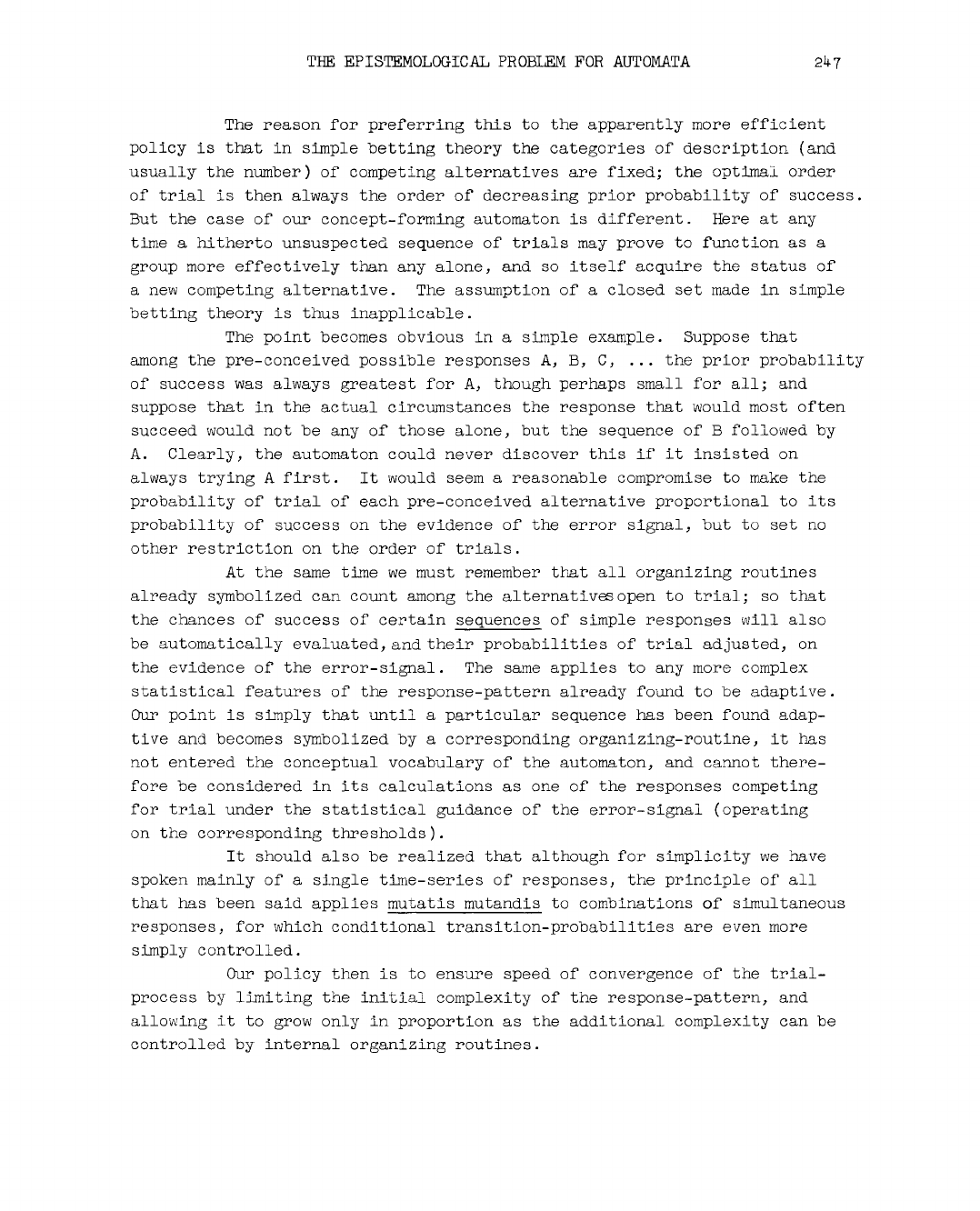
THE EPISTEMOLOGICAL PROBLEM FOR AUTOMATA
FIGURE k
The model, Illustrated in the figure, is made up of three
identical units (the number is unrestricted in principle) each comprising
a thyratron V which can actuate an electromagnetic gate G so as to drop a
ball-bearing from an aperture A over a two-pan balance B. B is mechan
ically linked to a potentiometer P, which governs the bias on thyratron V.
The anodes of all thyratrons are supplied from a common capacitor C
charged through a resistor R.
If now C is allowed to charge slowly, the thyratron with the
lowest effective bias, say Vn , will tend to fire first, discharging C and
releasing a ball from AQ . Normally this will fall into the right-hand
pan of Bn causing P^ to rotate and increase the bias on V . Thus the
normal effect of a thyratron1s firing is to reduce the probability of its
firing next time.
If, however, a target T is placed under A^ so as to deflect any
balls from An into the left-hand pan of Bn , the opposite effect will occur.
The success of the model in striking the target when Vn fires will increase
the probability that it will use V next time.
Evidently, no matter how the biases on different V's are set
initially, the model will tend to an equilibrium state in which only the
thyratron Vn fires and T is always hit. If, moreover, we move T to a new
position, m say, the model will gradually ’’unlearn" its original "set" and
eventually will be found firing only Vm .
In this example randomness is introduced only by the fluctua
tions of the thresholds of the various thyratrons, and the "evaluatory
feedback" is quantized and rather inflexible. It illustrates even so the
basic principle, whereby an automaton alters the transition probabilities

246
MacKAY
governing its own^activities according to its experience of their relative
success (judged by some general criterion) and diminishes by a kind of
"natural selection" the probabilities of all except those which have been
successful often, enough.
This is not the place to elaborate on engineering aspects of the
application of this principle to the hierarchy of Figure 3 . We must,
however, satisfy ourselves that a trial-and-error process could converge
quickly enough to be useful in the more general case.
It is first clear that if n independent thresholds must each be
set to one of a levels, then up to n log2 a binary choices may be re
quired to change from one configuration of thresholds to another. Even an
error-signal of m bits could guide such a change only after at least
(n/m) log2 a trials.
Clearly, until the higher-order statistical structure of events
begins to be abstracted, the automaton must begin by searching for adaptive
reactions from a very limited repertoire, if the search-process is to con
verge with any speed. It would seem sensible to begin with most thresholds
low, so that in effect the number of degrees of freedom of response is
small, the elements being coupled together in large groups. Spontaneous
activity would then be initially fast and furious, and would of course, in
a richly-interconnected system, include much random suppression of coupling
elements. This dissociative activity would amount to random augmentation
and alteration of the degrees of freedom of the response-system, and any
changes found useful could be statistically favoured- (See page 2 4 4 .)
As soon as simple adaptive activity began to show regularities,
the second-order mechanism of Figure 3 , on the same principle, could begin
to develop simple organizing routines to Improve the average overall
success. At this stage matching-responses would be crude and perhaps not
highly differentiated in their success-value from others; but as experi
ence of success and failure accumulated, and useful second-and higher-
order organizing routines began to develop, the speed of convergence on a
rough matching-response would increase and leave progressively more time
for exploratory development of finer response-structure before the environ
ment changed sufficiently to demand a new response.
It will be noted that this trial process is not organized for
maximum returns on simple betting principles. The response having maximum
likelihood of success, on the information contained in the error-signal,
is certainly most likely to be tried first, if the feedback from the error-
signal on the threshold-configuration is effective. But it will not always
take precedence; and any of the other responses with finite likelihoods
of success may sometimes be tried first instead, in the spontaneous
sequence of activity guided by the configuration of thresholds.

THE EPISTEMOLOGICAL PROBLEM FOR AUTOMATA
2k7
The reason for preferring this to the apparently more efficient
policy is that in simple betting theory the categories of description (and
usually the number) of competing alternatives are fixed; the optimal order
of trial is then always the order of decreasing prior probability of success.
But the case of our concept-forming automaton is different. Here at any
time a hitherto unsuspected sequence of trials may prove to function as a
group more effectively than any alone, and so itself acquire the status of
a new competing alternative. The assumption of a closed set made in simple
betting theory is thus inapplicable.
The point becomes obvious in a simple example. Suppose that
among the pre-conceived possible responses A, B, C, ... the prior probability
of success was always greatest for A, though perhaps small for all; and
suppose that in the actual circumstances the response that would most often
succeed would not be any of those alone, but the sequence of B followed by
A. Clearly, the automaton could never discover this if it insisted on
always trying A first. It would seem a reasonable compromise to make the
probability of trial of each pre-conceived alternative proportional to its
probability of success on the evidence of the error signal, but to set no
other restriction on the order of trials.
At the same time we must remember that all organizing routines
already symbolized can count among the alternatives open to trial; so that
the chances of success of certain sequences of simple responses will also
be automatically evaluated, and their probabilities of trial adjusted, on
the evidence of the error-signal. The same applies to any more complex
statistical features of the response-pattern already found to be adaptive.
Our point is simply that until a particular sequence has been found adap
tive and becomes symbolized by a corresponding organizing-routine, it has
not entered the conceptual vocabulary of the automaton, and cannot there
fore be considered in its calculations as one of the responses competing
for trial under the statistical guidance of the error-signal (operating
on the corresponding thresholds).
It should also be realized that although for simplicity we have
spoken mainly of a single time-series of responses, the principle of all
that has been said applies mutatis mutandis to combinations of simultaneous
responses, for which conditional transition-probabilities are even more
simply controlled.
Our policy then is to ensure speed of convergence of the trial-
process by limiting the initial complexity of the response-pattern, and
allowing It to grow only in proportion as the additional complexity can be
controlled by internal organizing routines.

2^8
MacKAY
The limitations set by the information-content of the error-
signals (discussed in Section ij-) now govern, not the speed of convergence,
but the rate of growth of complexity of response, and hence of conceptual
vocabulary. It is evident that even a multidimensional error-signal of
m bits can in the limit organize a vocabulary equivalent to not more than
nm binary symbols after n independent trials. This would require the
automaton to be presented with an ideally designed sample-flow of experi
ence, and is of course many times greater than what might be expected if
it were merely exposed to a typical human environment (including, of
course, normal dialogue).
But even these superficial considerations suggest that a con
ceptual vocabulary of the same order as the human one could in principle
be evolved in a time at least comparable with that required by a human
being if a suitable flux of experience were provided, even without external
evaluatory feedback from a human instructor.
Without such feedback there would of course be no guarantee that
the conceptual analysis of the field of activity developed by the automaton
would be in the same terms as the human one. Some of the concepts symbol
ized by the internal organizing routines might well be quite new, and
barely capable of translation unless the relevant modes of adaptive
response, and the criteria of "mismatch", were sufficiently analogous to
the human.
6. Comparison of the Two Approaches
We are now in a position to make a few general remarks on the
two principles of representation, by way of summary.
We may first note that even in the second type of automaton,
the error-signal can itself be regarded as a representation working on the
first principle: i.e., as a transform of the input, flowing from left to
right. True, it represents, not the world in isolation, but (within the
limits of its predetermined information-space) the nature and extent of
the mismatch between the automaton and the world. But it is linked to the
incoming signals by a simple one-way causal chain.
We have seen that the second type of automaton can function
adaptively, given time, even if the error-signal is one-dimensional. The
greater the statistical redundancy in the environmental activity to which
continuous adaptation is required, the more complex the adaptive reac
tions attainable in given time with a given error-signal, and the less the
complexity of the error-signal required for a given complexity and speed
of response.
The more complex the error-signal, the less complex need be the

THE EPISTEMOLOGICAL PROBLEM FOR AUTOMATA
statistical abstractive mechanism required to attain a given adaptive
efficiency, and the more information can be taken in in a single "glimpse,f.
All this suggests that we might regard the first 11 fully-informed"
type of automaton (Figure 1 ) as simply the other extreme case of the second
type (Figures 2 and 3 ), in which the error-signal has been enlarged in
information-content sufficiently to represent all that Is necessary of the
field of activity or "world of discourse".
The only "comparator" is in this case the field of activity
itself. All the organizing routines with their operational significance
as dynamic symbols of statistical expectations are missing.
Evidently the fully-informed automaton will give best returns
for the complexity of its corrective information when dealing with situa
tions of minimum redundancy.^ But if redundancy is high enough, an automa
ton of the second type with a relatively simple error-indicating system can
in principle respond as efficiently as a fully-informed automaton in the
same situation. The second type is at its best in situations where redun
dancy is at a maximum.
Most significant, however, is the distinction between the con
ceptual range of the two types.
In the first the conceptual framework is predesigned, and
"thinking", if such we call it, is confined to its categories. In the
second the conceptual framework evolves to match the stationary statistical
features of the world, and new hypotheses - in the form of tentative
organizing routines - are always being framed.
If, moreover, the abstractive system is allowed to include in
its data the activity (at various levels) of its own organizing routines,
we have the possiblity of symbolic activity representing in effect
metalinguistic concepts. It is difficult to set any limits to the types
of conceptual activity that are thus within the scope of an automaton
on this principle.
It is of some interest that the operational equivalent of an event
of perception in the second case is the framing of a satisfactory internal
matching-response, which is thereby distinguished from the events of
reception.
^This is to assume that the representation "filtered" from the input
signal can appear with negligible delay: a potentially costly require
ment. In general the most economical filter would also benefit from
redundancy in the input.
..................Content has been hidden....................
You can't read the all page of ebook, please click here login for view all page.
